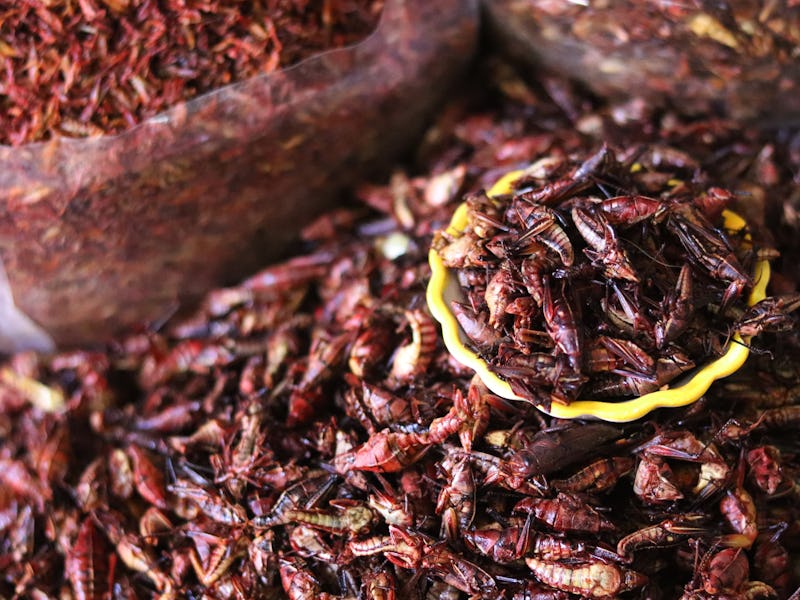Edible Insects Revealed to Pack a Nutrient Punch Beyond Just Protein
New research suggests replacing orange juice with grasshoppers.

A quarter of the world’s population regularly eats insects not just for nutrition, but also because they like the taste of them. Mexican red worms have a smoky taste when eaten raw, while termites taste like crispy bacon after being boiled and sautéed with salt. Wood ants have a distinct lemony flavor, while honey ants are more like wild strawberries. The lychee stink bug, meanwhile, is more like munching on an apple skin.
But scientists know it’ll take more than the promise of good flavor to get Western consumers on the bug-eating train. So in the effort to support the case for eating insects, an Italian research team recently evaluated the antioxidant levels in commercially available edible insects.
On Monday, they reported promising news in the journal Frontiers in Nutrition: Some insects are just as — if not more — antioxidant-rich as mainstay “superfoods” like orange juice and olive oil.
“Edible insects are an excellent source of protein, polyunsaturated fatty acids, minerals, vitamins, and fiber,” explains lead author Mauro Serafini, Ph.D., a researcher at the University of Teramo in Italy. “But until now, nobody had compared them with classical functional foods such as olive oil or orange juice in terms of antioxidant activity.”
A plate of deep-friend grasshoppers and bamboo worms.
To make this comparison, Serafini and his team rounded up a range of insects and invertebrates, including grasshoppers, scorpions, and black tarantulas, took off the inedible bits like wings and stings, and ground them up. They then separated those bits into two parts — the animals’ fat and everything else that looked like it could dissolve in water. Subsequently, the researchers tested those materials, as well as fresh orange juice and olive oil, for antioxidant content and activity.
They discovered that the water-soluble extracts of grasshoppers, silkworms, and crickets displayed an antioxidant capacity that was fivefold higher than that of the orange juice. When they added water to the mix, they found that the insect-dust then had about 75 percent the antioxidant activity of orange juice.
Meanwhile, when it came to examining the insect fat, they observed that the fat from giant cicadas and silkworms showed twice the antioxidant activity of olive oil. In both evaluation groups, black tarantulas ranked among the lowest in antioxidant levels — so arachnophobes don’t need to think too seriously about eating the object of their phobia yet.
“There’s a clear trend,” Serafini says. “The vegetarians have markedly higher antioxidant capacity.”
But a major question still remains: What does this antioxidant capacity really mean? Scientist don’t love the term “antioxidants” because it can mislead consumers into thinking there’s a one-size-fits-all approach to the nutrients. Hundreds of different substances can act as antioxidants, including vitamin C, vitamin E, and the mineral manganese, just to name a few. Each antioxidant has a unique chemical behavior, and they are not believed to be interchangeable.
On the other hand, studies do indicate that consuming foods rich in antioxidants, like fruits and vegetables, helps prevent oxidative stress-related diseases such as cardiovascular disease, diabetes, and cancer.
The idea is that antioxidants help protect our bodies from unstable molecules called free radicals — these are naturally formed when our body converts food to energy, but we can also be exposed to them via environmental sources like cigarette smoke and air pollution.
However, it’s not clear whether it’s specifically the antioxidants in fruits and vegetables that are protecting people against disease. Many studies on the topic are inconclusive or contradictory.
The team behind this latest paper acknowledges that it’s not enough to just say that bugs have antioxidants and be done with it. They write that what’s needed now are new studies designed to examine exactly how the antioxidant properties of edible insects and invertebrates affect humans. If it turns out the antioxidants support human health, then it could be possible to adapt the insects in a way that will maximize their antioxidant content for animal or human consumption.
And if it turns out the antioxidants don’t do much, well, insects are still a totally valid source of proteins, minerals, and vitamins — not to mention a variety of unique tastes.
Abstract:
A new global interest in entomophagy, the practice of eating insects, and invertebrates, arise from the impellent necessity of preserving agriculture resources and to obtain a drastic reduction of the ecological impact of animal food on the planet. The composite nutritional content, direct consequences of a plant-based feeding, associated with the undoubtedly ecological properties, suggest for insects a role as sustainable and functional foods. We aim to investigate the ability of water and liposoluble extracts, obtained by 12 commercially available edible insects and two invertebrates, to display an antioxidant effect in vitro. Results show that water-soluble extracts of grasshoppers, silkworm, and crickets display the highest values of antioxidant capacity (TEAC), 5-fold higher than fresh orange juice, while evening cicada, giant water bugs, Thai zebra tarantula, and black scorpions have negligible values. Grasshoppers, African caterpillars, and crickets have the highest levels of reducing power (FRAP), double than fresh orange juice. Grasshoppers, black ants, and mealworms contain the highest levels of total polyphenols, while Thai zebra tarantula, black scorpions, and giant water bugs are positioned at the bottom of the ranking. The liposoluble fraction of silkworm, evening cicada, and African caterpillars shows highest level of TEAC, twice than olive oil, while Thai zebra tarantula, palm worm, and black ants are placed at the bottom of the ranking. Edible insects and invertebrates represent a potential source of antioxidant ingredients with an efficiency related to their taxonomy and eating habits. More evidences are needed in order to understand if the practice of eating insects and invertebrates might contribute to modulate oxidative stress in humans.